255. Crowned Lapwing Vanellus coronatus (Kroonkiewiet)
Order: Charadriiformes. Family: Charadriidae
Description
30 cm. It has sandy-brown sides of the face, neck, upper breast and upperparts. The rest of the underparts are white, with a black band between the brown breast and white belly. The forehead is black, extending back above the eye to the nape. It is separated from the black crown by a white band. Eye-colour is pale yellow and the bill is red with a black tip. The legs and feet are orange-red. Legs and bill duller, more pinkish red in non-breading season. It shows black flight feathers in flight and a broad white bar running across the wing. Sexes alike.
Juvenile has a buff-brown forehead. Crown band buffy. Upperparts buff fringed.
Similar species: This large lapwing, with its distinctive pendulous, yellow wattles, might be confused with African Wattled Lapwing, but the latter species has a dark (not white) breast.
Distribution
Sub-Saharan Africa: From Ethiopia, Sudan and Democratic Republic of Congo, south to South Africa.
Habitat
Short grassland (either grazed or burnt), dry open ground; also on golf courses, playing fields and fallow land.
Diet
Its diet consists mainly of insects and larvae particularly termites, ants, beetles and crickets.
Breeding
Usually a monogamous, territorial solitary nester, although polygamy is rarely recorded. The nest is a scrape in the ground, lined with dried grass, roots, small stones and dried dung and typically placed on bare ground or among short vegetation, sometimes adjacent to a stone or mound of earth. Egg-laying season is year-round, peaking from August-December. It lays 2-4 eggs, which are mainly incubated by the female, although the male occasionally takes over if it gets particularly hot. The chicks leave the nest after about four hours, once their down is dry; the adults take turns in caring for the chicks and directing them to food items. They eventually fledge at about 29-31 days old, becoming fully independent at the onset of the following breeding season, a year later.
Call
Strident shreeek, shreeek calls, accelerating to excited kreep-kreep-kreeipnotes in flight. Listen to Bird Call
Status
Widespread resident, sedentary but undertakes local movements to more suitable habitats (shorter grass) if necessary; in non-breeding season flocks of 10-40 birds.
Africa Wild Bird Book
- Lisbeth
- Site Admin
- Posts: 65591
- Joined: Sat May 19, 2012 12:31 pm
- Country: Switzerland
- Location: Lugano
- Contact:
Crowned Lapwing
"Education is the most powerful weapon which you can use to change the world." Nelson Mandela
The desire for equality must never exceed the demands of knowledge
The desire for equality must never exceed the demands of knowledge
- Lisbeth
- Site Admin
- Posts: 65591
- Joined: Sat May 19, 2012 12:31 pm
- Country: Switzerland
- Location: Lugano
- Contact:
Crowned Lapwing Photos
255. Crowned Lapwing Vanellus coronatus
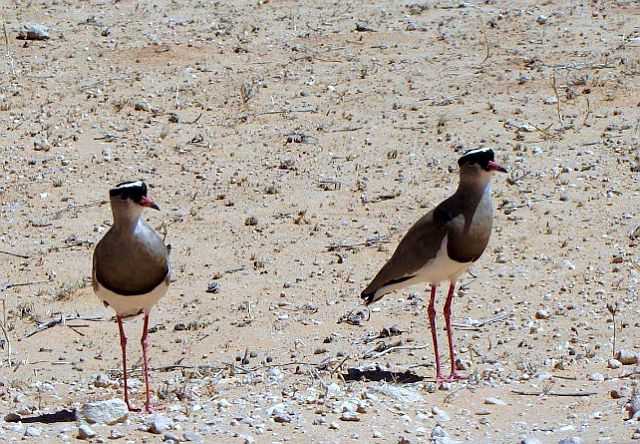 © Lisbeth
© Lisbeth
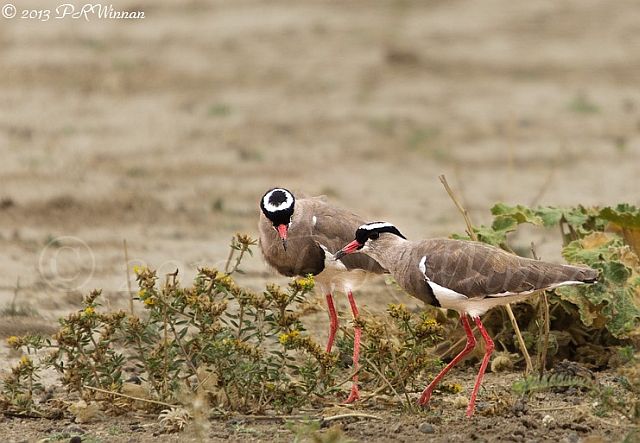 © PRWIN
© PRWIN
Kgalagadi Transfrontier Park
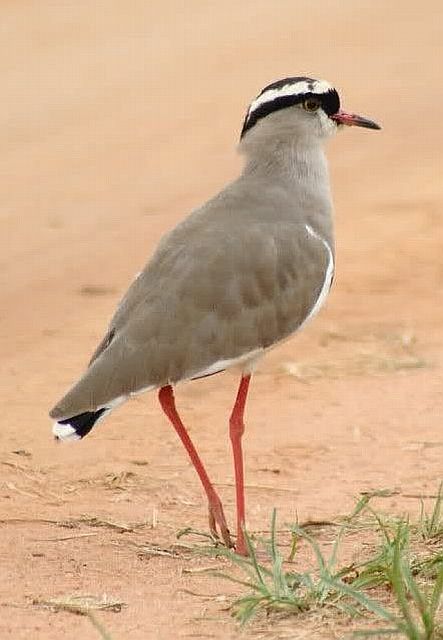 © Flutterby
© Flutterby
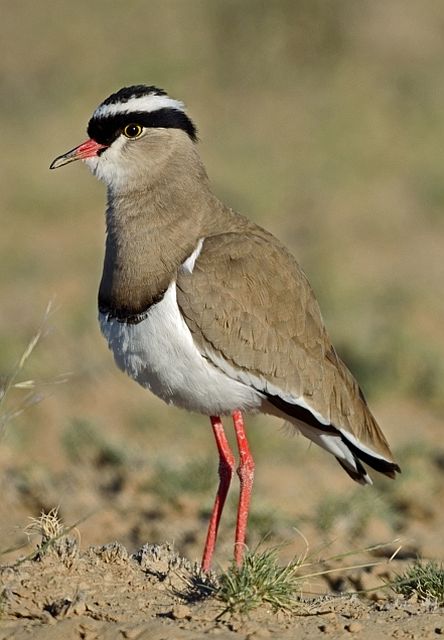 © BluTuna
© BluTuna
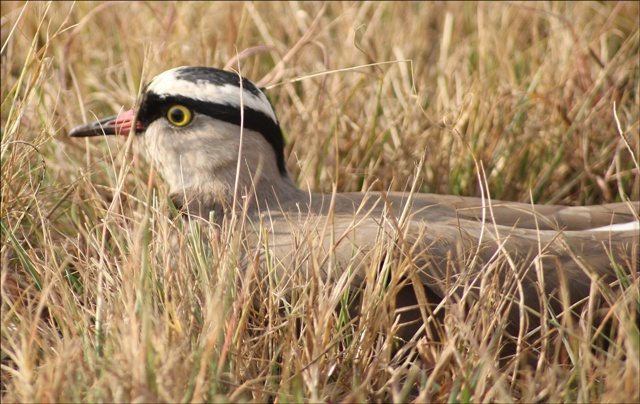 © Amoli
© Amoli
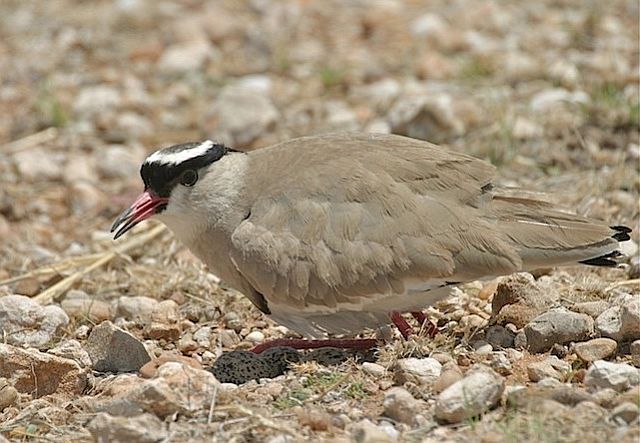 © ExFmem
© ExFmem
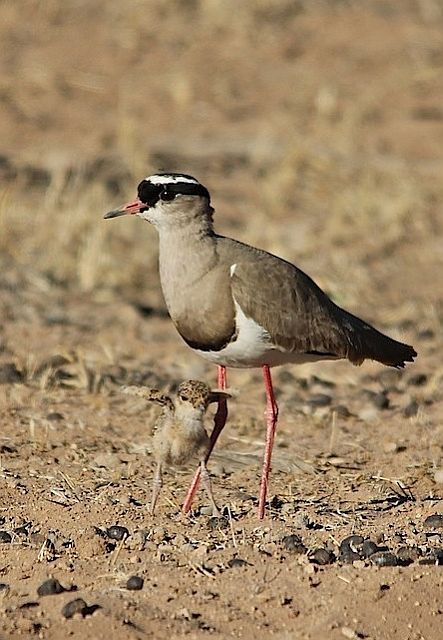 © ExFmem
© ExFmem
Links:
http://sabap2.adu.org.za/docs/sabap1/255.pdf
http://sabap2.adu.org.za/spp_summary.ph ... §ion=3
 © Lisbeth
© Lisbeth © PRWIN
© PRWINKgalagadi Transfrontier Park
 © Flutterby
© Flutterby  © BluTuna
© BluTuna © Amoli
© Amoli © ExFmem
© ExFmem © ExFmem
© ExFmemLinks:
http://sabap2.adu.org.za/docs/sabap1/255.pdf
http://sabap2.adu.org.za/spp_summary.ph ... §ion=3
"Education is the most powerful weapon which you can use to change the world." Nelson Mandela
The desire for equality must never exceed the demands of knowledge
The desire for equality must never exceed the demands of knowledge
- Flutterby
- Posts: 44029
- Joined: Sat May 19, 2012 12:28 pm
- Country: South Africa
- Location: Gauteng, South Africa
- Contact:
African Wattled Lapwing
260. African Wattled Lapwing (Formerly known as Wattled Plover) Vanellus senegallus (Lelkiewiet)
ORDER CHARADRIIFORMES. Family Charadriidae
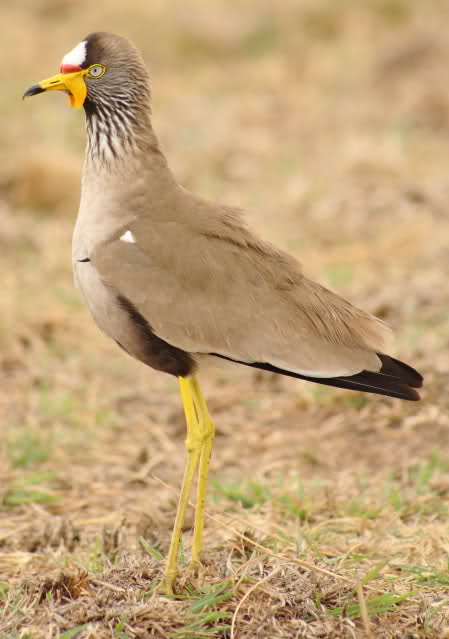
Description
Largest lapwing in the region. Has red bases to the wattles, streaked neck, grey breast, white on the forecrown and forehead. Sexes are alike.
Juveniles have smaller wattles and less distinct head markings.
Distribution
Western parts of South Africa.
Habitat
Waterlogged or moist short grassland, on the edge of seeps, streams, marshes and floodplains. Forages in adjacent agricultural lands, burnt grasslands and occurs around human habitation in non-breeding season.
Diet
Mainly insects like grasshoppers, beetles, caterpillars, crickets and termites; also worms and some grass seeds.
Breeding
Monogamous. Nest scrape usually placed on bare ground or in short damp or dry grassland.
Call
High-pitched keep-keep-keep, rising in pitch. Very noisy during br season, often calling at night. Listen to Bird call.
Status
Fairly common resident, with some local migratory and nomadic movements recorded after br. Found singly, in pairs and in flocks in non-breeding season. Often associated with low termite mounds, which it uses as lookout perches.
ORDER CHARADRIIFORMES. Family Charadriidae

Description
Largest lapwing in the region. Has red bases to the wattles, streaked neck, grey breast, white on the forecrown and forehead. Sexes are alike.
Juveniles have smaller wattles and less distinct head markings.
Distribution
Western parts of South Africa.
Habitat
Waterlogged or moist short grassland, on the edge of seeps, streams, marshes and floodplains. Forages in adjacent agricultural lands, burnt grasslands and occurs around human habitation in non-breeding season.
Diet
Mainly insects like grasshoppers, beetles, caterpillars, crickets and termites; also worms and some grass seeds.
Breeding
Monogamous. Nest scrape usually placed on bare ground or in short damp or dry grassland.
Call
High-pitched keep-keep-keep, rising in pitch. Very noisy during br season, often calling at night. Listen to Bird call.
Status
Fairly common resident, with some local migratory and nomadic movements recorded after br. Found singly, in pairs and in flocks in non-breeding season. Often associated with low termite mounds, which it uses as lookout perches.
- Flutterby
- Posts: 44029
- Joined: Sat May 19, 2012 12:28 pm
- Country: South Africa
- Location: Gauteng, South Africa
- Contact:
African Wattled Lapwing Photos
260. African Wattled Lapwing (Formerly known as Wattled Plover) Vanellus senegallus (Lelkiewiet)
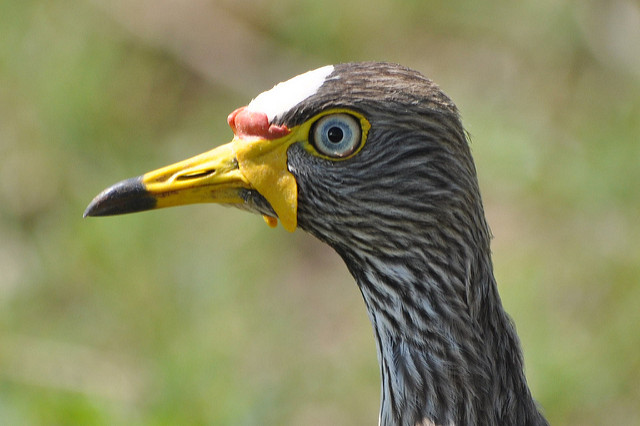 © steamtrainfan
© steamtrainfan
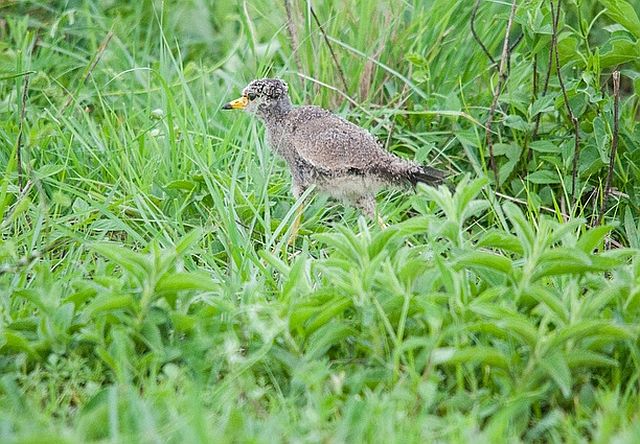 © steamtrainfan
© steamtrainfan
Chick, Rietvlei Nature Reserve, Gauteng
© Lisbeth
Immature, Kruger National Park
Links:
http://sabap2.adu.org.za/docs/sabap1/260.pdf
http://sabap2.adu.org.za/spp_summary.ph ... §ion=3
 © steamtrainfan
© steamtrainfan © steamtrainfan
© steamtrainfanChick, Rietvlei Nature Reserve, Gauteng
© Lisbeth
Immature, Kruger National Park
Links:
http://sabap2.adu.org.za/docs/sabap1/260.pdf
http://sabap2.adu.org.za/spp_summary.ph ... §ion=3
Grey Plover
254. Grey Plover Pluvialis squatarola (Grysstrandkiewiet)
Order: Charadriiformes. Family: Charadriidae
Description
A large, chunky build Pluvialis plover with totally white undertail coverts. Shows black axillaries (wingpits) in all plumages and a big, strong bill, the legs look shortish. Has a tiny hind toe which the other Pluvialis plovers lack. Iris dark brown; bill black; legs and feet grey.
Non-breeding: Above brownish grey mottled with whitish or buff; rump white (no white on rump of Asiatic Golden Plover); below white, mottled grey and buff on chest; ear coverts dark; in flight underwing white with black axillaries (best field character); tail barred. The supercilium is quite prominent.
Breeding: Both partial breeding plumage and full breeding plumage occur in spring and autumn. Above upperside metallic bicoloured back with black and white spots, and front black from eyes down to between the legs; the black area is adjacent to a broad white band from forecrown to upper breast, but the black area disappears behind the wings by the lower breast. Males have slightly more extensive and solid black than females. Undertail white (black in Asiatic Golden Plover); when moulting into breeding plumage, black of underparts appears first on chest.
Juvenile: Mottled above with pale gold, but always distinguishable from Asiatic Golden Plover in flight by black axillaries. Streaked breast and pale cap.
Similar species: In non-breeding plumage it might be mistaken for an American Golden Plover but it is larger than that species and has no trace of golden flecks on the mantle or wing coverts.
Distribution
Breeds in Arctic tundra from the White Sea of north-western Europe across Asia to northern Canada, heading south in the non-breeding season to coasts across the world between 55° North and 40° South. In southern Africa it is common along the coast, while it is a vagrant further inland.
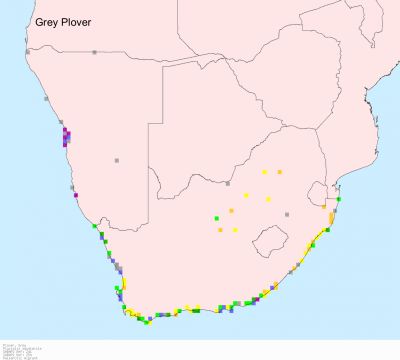
Movements and migrations
Southern African birds are thought to originate from the Taimyr Peninsula, Siberia, departing in August and heading south through Ukraine, Romania and Italy before eventually arriving in southern Africa in September. It leaves the region in the period from February-April, mainly in April.
Habitat
It prefers muddy or sandy intertidal areas of estuaries, sandy or rocky coasts; less commonly on larger shallow inland waters.
Diet
It mainly eats intertidal invertebrates, especially polychaete worms, typically using the typical, run-stop-search technique of plovers. It hunts visually by day and night, although it takes longer for it to locate small animals in the dark.
Breeding
Extralimital. Monogamous, often for several years. Their breeding habitat is Arctic islands and coastal areas across the northern coasts of Alaska, Canada, and Russia. They nest on the ground in a dry open tundra with good visibility; the nest is a shallow gravel scrape. Four eggs (sometimes only three) are laid in early June, with an incubation period of 26–27 days; the chicks fledge when 35–45 days old.
Call
Far carrying melodious whistle tlooo, tlui-tlui, or 3-syllabled too-ee-u, lower in tone on middle syllable.
Status
Fairly common to common non-breedingeeding Palaearctic migrant, August to May; some birds overwinter on S and W coasts. The Grey Plover is classified as Least Concern (LC) on the IUCN Red List
Order: Charadriiformes. Family: Charadriidae
Description
A large, chunky build Pluvialis plover with totally white undertail coverts. Shows black axillaries (wingpits) in all plumages and a big, strong bill, the legs look shortish. Has a tiny hind toe which the other Pluvialis plovers lack. Iris dark brown; bill black; legs and feet grey.
Non-breeding: Above brownish grey mottled with whitish or buff; rump white (no white on rump of Asiatic Golden Plover); below white, mottled grey and buff on chest; ear coverts dark; in flight underwing white with black axillaries (best field character); tail barred. The supercilium is quite prominent.
Breeding: Both partial breeding plumage and full breeding plumage occur in spring and autumn. Above upperside metallic bicoloured back with black and white spots, and front black from eyes down to between the legs; the black area is adjacent to a broad white band from forecrown to upper breast, but the black area disappears behind the wings by the lower breast. Males have slightly more extensive and solid black than females. Undertail white (black in Asiatic Golden Plover); when moulting into breeding plumage, black of underparts appears first on chest.
Juvenile: Mottled above with pale gold, but always distinguishable from Asiatic Golden Plover in flight by black axillaries. Streaked breast and pale cap.
Similar species: In non-breeding plumage it might be mistaken for an American Golden Plover but it is larger than that species and has no trace of golden flecks on the mantle or wing coverts.
Distribution
Breeds in Arctic tundra from the White Sea of north-western Europe across Asia to northern Canada, heading south in the non-breeding season to coasts across the world between 55° North and 40° South. In southern Africa it is common along the coast, while it is a vagrant further inland.

Movements and migrations
Southern African birds are thought to originate from the Taimyr Peninsula, Siberia, departing in August and heading south through Ukraine, Romania and Italy before eventually arriving in southern Africa in September. It leaves the region in the period from February-April, mainly in April.
Habitat
It prefers muddy or sandy intertidal areas of estuaries, sandy or rocky coasts; less commonly on larger shallow inland waters.
Diet
It mainly eats intertidal invertebrates, especially polychaete worms, typically using the typical, run-stop-search technique of plovers. It hunts visually by day and night, although it takes longer for it to locate small animals in the dark.
Breeding
Extralimital. Monogamous, often for several years. Their breeding habitat is Arctic islands and coastal areas across the northern coasts of Alaska, Canada, and Russia. They nest on the ground in a dry open tundra with good visibility; the nest is a shallow gravel scrape. Four eggs (sometimes only three) are laid in early June, with an incubation period of 26–27 days; the chicks fledge when 35–45 days old.
Call
Far carrying melodious whistle tlooo, tlui-tlui, or 3-syllabled too-ee-u, lower in tone on middle syllable.
Status
Fairly common to common non-breedingeeding Palaearctic migrant, August to May; some birds overwinter on S and W coasts. The Grey Plover is classified as Least Concern (LC) on the IUCN Red List
Grey Plover Photos
254. Grey Plover Pluvialis squatarola (Grysstrandkiewiet)
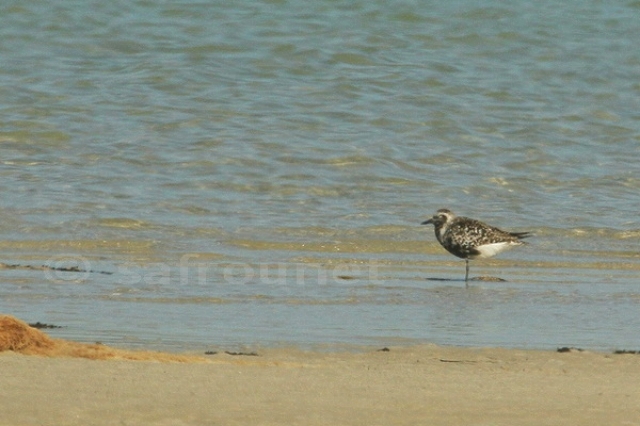 © nan
© nan
West Coast National Park, Western Cape
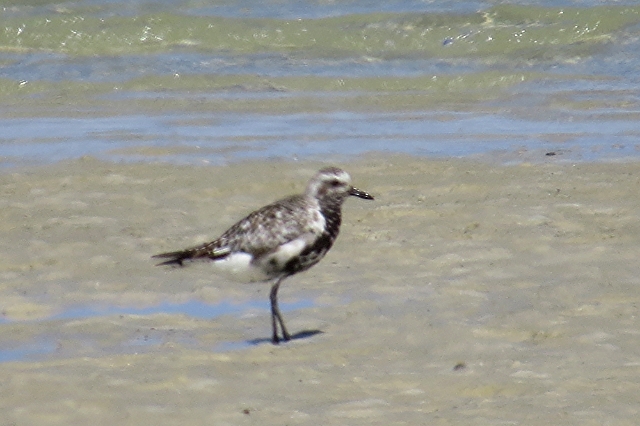 © Tina
© Tina
West Coast National Park, Western Cape
 © Tina
© Tina
Juvenile, West Coast National Park, Western Cape
Links:
http://sabap2.adu.org.za/docs/sabap1/254.pdf
http://sabap2.adu.org.za/species_info.p ... #menu_left
 © nan
© nanWest Coast National Park, Western Cape
 © Tina
© TinaWest Coast National Park, Western Cape
 © Tina
© TinaJuvenile, West Coast National Park, Western Cape
Links:
http://sabap2.adu.org.za/docs/sabap1/254.pdf
http://sabap2.adu.org.za/species_info.p ... #menu_left
Common Ringed Plover
245. Common Ringed Plover Charadrius hiaticula (Ringnekstrandkiewiet)
Order: Charadriiformes. Family: Charadriidae
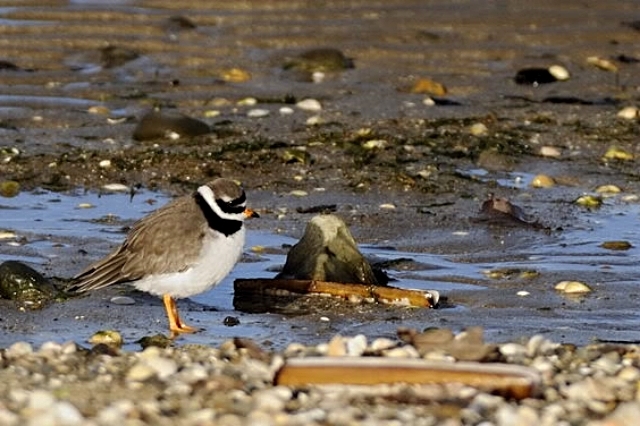
Breeding plumage
Description
Length: 18-20 cm. Wingspan: 48–57 cm. Weight: 42–78 g. A small, short-legged, dark plover with sandy brown upperparts, white underparts, black mask, a white collar above a blackish brown breast band that is often incomplete in non-breeding plumage. In flight, the narrow, white wingbar and collar are distinctive. Black tipped yellow-orange bill. A yellow ring surrounds each eye. The legs are orange and only the outer two toes are slightly webbed.
The sexes are similar in appearance, although the breast band is usually tinged with brown on the female.
The juvenile has duller plumage and has an incomplete breastband.
Similar species: This species may be distinguished from Greater Sandplover and Lesser Sand Plover by the combination of the collar, the smaller size, the lighter bill with orange base and the orange-yellow legs.
Distribution
Breeds in the circumpolar region, in Europe from Northern France up to the Arctic and also Northeast Arctic Canada; mainly above 60° North, but largely excluding Alaska and north-western Canada, heading south in the non-breeding season to the Arabian Peninsula, Iran and sub-Saharan Africa. In southern Africa it is common along the coast, as well as in northern and south-eastern Botswana, southern Mozambique and patches of Namibia and central South Africa. Some populations are resident, but others migrate South to Africa. Occurs throughout the sub-region in suitable habitat.
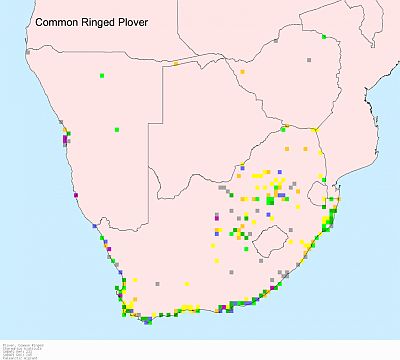
Habitat
Coastal and inland wetlands: Coastal mudflats, sandy beaches, freshwater lakesides.It generally prefers estuaries and lagoons on the coastline, while inland it favours mud and sand banks along the shore of rivers and wetlands, sewage works and salt pans.
Movements and migrations
Palearctic breeding migrant, travelling the great distance from its northern breeding grounds, through the East African coast to southern Africa. Here it arrives in the period from September-November, eventually leaving from late February-April.
Diet
Insects, crustaceans & worms. It mainly eats aquatic invertebrates, foraging by day and night using the technique typical of plovers, repeatedly running, stopping then searching for prey to pluck from the ground or water surface.
Breeding
The nest is a shallow scrape in the ground lined with pebbles and vegetation. The parents are extremely aggressive around the nest and will fiercely defend it by calling loudly and swooping at intruders. Usually four eggs are laid per brood, at intervals of one to three days, and are subsequently incubated by both the male and female for some 21 to 27 days. The chicks fledge after around 24 days in the nest, but few survive past their first year, although those that do may live to 10 years of age.
Call
The call is coo-eep. Contact call a flutty tooLEE. Listen to Bird Call.
Status
Uncommon summer visitor to the region. Some overwinter. Not threatened, although its southern African population is thought to have decreased in size since the late 1900s, probably caused by the degradation of wetlands. The Common Ringed Plover is classified as Least Concern (LC) on the IUCN Red List.
Order: Charadriiformes. Family: Charadriidae

Breeding plumage
Description
Length: 18-20 cm. Wingspan: 48–57 cm. Weight: 42–78 g. A small, short-legged, dark plover with sandy brown upperparts, white underparts, black mask, a white collar above a blackish brown breast band that is often incomplete in non-breeding plumage. In flight, the narrow, white wingbar and collar are distinctive. Black tipped yellow-orange bill. A yellow ring surrounds each eye. The legs are orange and only the outer two toes are slightly webbed.
The sexes are similar in appearance, although the breast band is usually tinged with brown on the female.
The juvenile has duller plumage and has an incomplete breastband.
Similar species: This species may be distinguished from Greater Sandplover and Lesser Sand Plover by the combination of the collar, the smaller size, the lighter bill with orange base and the orange-yellow legs.
Distribution
Breeds in the circumpolar region, in Europe from Northern France up to the Arctic and also Northeast Arctic Canada; mainly above 60° North, but largely excluding Alaska and north-western Canada, heading south in the non-breeding season to the Arabian Peninsula, Iran and sub-Saharan Africa. In southern Africa it is common along the coast, as well as in northern and south-eastern Botswana, southern Mozambique and patches of Namibia and central South Africa. Some populations are resident, but others migrate South to Africa. Occurs throughout the sub-region in suitable habitat.

Habitat
Coastal and inland wetlands: Coastal mudflats, sandy beaches, freshwater lakesides.It generally prefers estuaries and lagoons on the coastline, while inland it favours mud and sand banks along the shore of rivers and wetlands, sewage works and salt pans.
Movements and migrations
Palearctic breeding migrant, travelling the great distance from its northern breeding grounds, through the East African coast to southern Africa. Here it arrives in the period from September-November, eventually leaving from late February-April.
Diet
Insects, crustaceans & worms. It mainly eats aquatic invertebrates, foraging by day and night using the technique typical of plovers, repeatedly running, stopping then searching for prey to pluck from the ground or water surface.
Breeding
The nest is a shallow scrape in the ground lined with pebbles and vegetation. The parents are extremely aggressive around the nest and will fiercely defend it by calling loudly and swooping at intruders. Usually four eggs are laid per brood, at intervals of one to three days, and are subsequently incubated by both the male and female for some 21 to 27 days. The chicks fledge after around 24 days in the nest, but few survive past their first year, although those that do may live to 10 years of age.
Call
The call is coo-eep. Contact call a flutty tooLEE. Listen to Bird Call.
Status
Uncommon summer visitor to the region. Some overwinter. Not threatened, although its southern African population is thought to have decreased in size since the late 1900s, probably caused by the degradation of wetlands. The Common Ringed Plover is classified as Least Concern (LC) on the IUCN Red List.
Dewi
What is the good of having a nice house without a decent planet to put it on? (H D Thoreau)
What is the good of having a nice house without a decent planet to put it on? (H D Thoreau)
Common Ringed Plover Photos
245. Common Ringed Plover Charadrius hiaticula
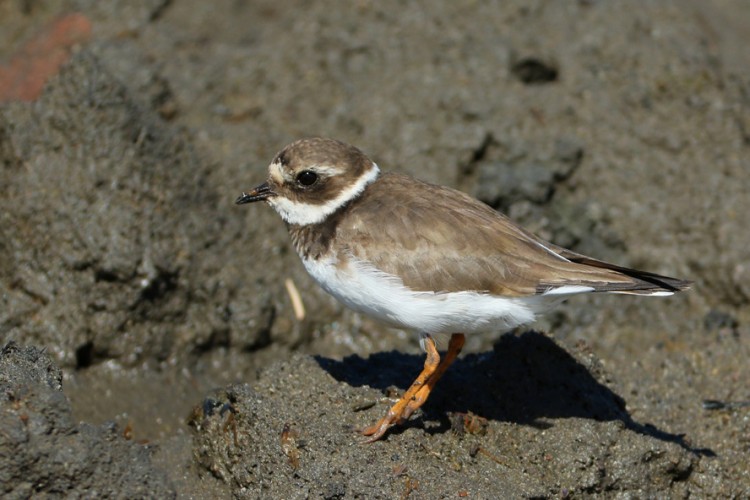
Macaneta Wetlands, about 30 kms north of Maputo © Dindingwe
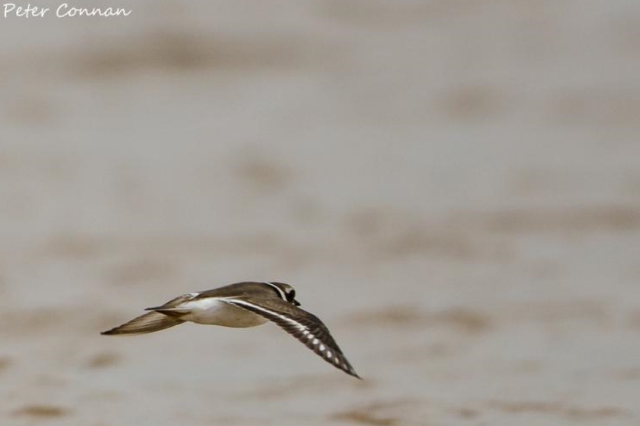 © Peter Connan
© Peter Connan
Maphelane, iSimangaliso Wetland Park, KwaZulu-Natal
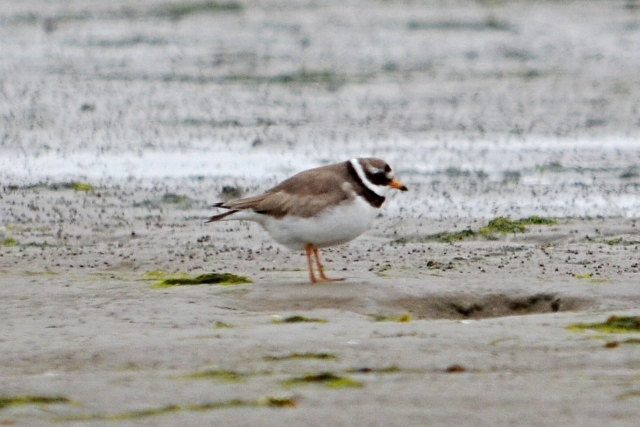 © Mel
© Mel
Breeding plumage
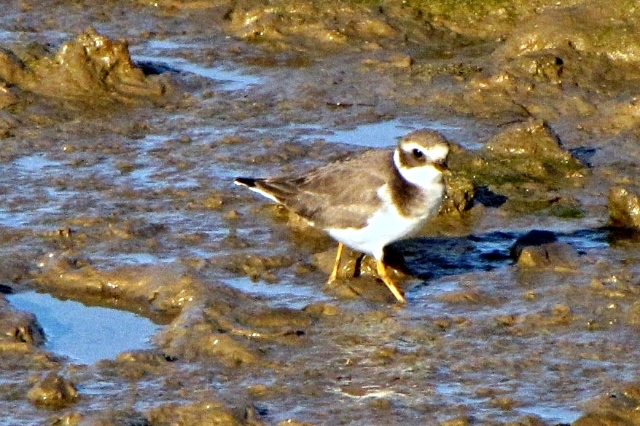 © Lisbeth
© Lisbeth
Algarve, Portugal
Links:
Sabap2
Species Text Sabap1
Macaneta Wetlands, about 30 kms north of Maputo © Dindingwe
 © Peter Connan
© Peter ConnanMaphelane, iSimangaliso Wetland Park, KwaZulu-Natal
 © Mel
© MelBreeding plumage
 © Lisbeth
© LisbethAlgarve, Portugal
Links:
Sabap2
Species Text Sabap1
Dewi
What is the good of having a nice house without a decent planet to put it on? (H D Thoreau)
What is the good of having a nice house without a decent planet to put it on? (H D Thoreau)
Little-ringed Plover
Little-ringed Plover Charadrius dubius (Kleinringnekstrandkiewiet)
Order: Charadriiformes. Family: Charadriidae
Description
17 cm. A small plover with a distinctive black and white head pattern. It has a brown cap, a white forehead, a black mask around the eyes with white above and a short dark bill. Conspicuous yellow eye-ring. Sandy brown back with white underparts. Single black breast band. It has a short black bill and pale flesh-colouredlegs.
Similar species: A very similar species to the slightly larger Common Ringed Plover. The most obvious differences are the yellow eye ring and all black bill in the Little Ringed Plover. Its legs are also reddish compared with the orange legs of the Common Ringed Plover.
Distribution
Palearctic. Breeds from northern Eurasia to northern Africa, heading south in the non-breeding season to Malaysia, southern Asia and Africa above the equator, from Senegal to Somalia and Kenya. It is a rare vagrant to southern Africa, with just a single confirmed record at Hwange National Park, Zimbabwe from 5-8th January 2002.
This species is fully migratory in much of its range. The European and North African populations migrate across the Sahara Desert between late-July and early-September (leaving breeding grounds June to mid-July) to reach wintering grounds in tropical Africa from late-August onwards.
Habitat
It generally prefers muddy and sandy shores of rivers and freshwater lakes, as well as airstrips, pastures and short grassy areas near water.
Diet
Mostly aquatic invertebrates. It mainly eats invertebrates, using the typical plover foraging technique of running, stopping and searching repeatedly, or alternatively catching prey disturbed by stirring its feet in shallow water.
Breeding
Their breeding habitat is open gravel areas near freshwater, including gravel pits, islands and river edges in Europe and western Asia. They nest on the ground on stones with little or no plant growth. Both male and female take turn to incubate the eggs.
Call
Loud pee-oo. Listen to Bird Call.
Status
Extremely rare vagrant (one record from Zimbabwe)
Order: Charadriiformes. Family: Charadriidae
Description
17 cm. A small plover with a distinctive black and white head pattern. It has a brown cap, a white forehead, a black mask around the eyes with white above and a short dark bill. Conspicuous yellow eye-ring. Sandy brown back with white underparts. Single black breast band. It has a short black bill and pale flesh-colouredlegs.
Similar species: A very similar species to the slightly larger Common Ringed Plover. The most obvious differences are the yellow eye ring and all black bill in the Little Ringed Plover. Its legs are also reddish compared with the orange legs of the Common Ringed Plover.
Distribution
Palearctic. Breeds from northern Eurasia to northern Africa, heading south in the non-breeding season to Malaysia, southern Asia and Africa above the equator, from Senegal to Somalia and Kenya. It is a rare vagrant to southern Africa, with just a single confirmed record at Hwange National Park, Zimbabwe from 5-8th January 2002.
This species is fully migratory in much of its range. The European and North African populations migrate across the Sahara Desert between late-July and early-September (leaving breeding grounds June to mid-July) to reach wintering grounds in tropical Africa from late-August onwards.
Habitat
It generally prefers muddy and sandy shores of rivers and freshwater lakes, as well as airstrips, pastures and short grassy areas near water.
Diet
Mostly aquatic invertebrates. It mainly eats invertebrates, using the typical plover foraging technique of running, stopping and searching repeatedly, or alternatively catching prey disturbed by stirring its feet in shallow water.
Breeding
Their breeding habitat is open gravel areas near freshwater, including gravel pits, islands and river edges in Europe and western Asia. They nest on the ground on stones with little or no plant growth. Both male and female take turn to incubate the eggs.
Call
Loud pee-oo. Listen to Bird Call.
Status
Extremely rare vagrant (one record from Zimbabwe)
Dewi
What is the good of having a nice house without a decent planet to put it on? (H D Thoreau)
What is the good of having a nice house without a decent planet to put it on? (H D Thoreau)
Little-ringed Plover Photos
Little-ringed Plover Charadrius dubius (Kleinringnekstrandkiewiet)
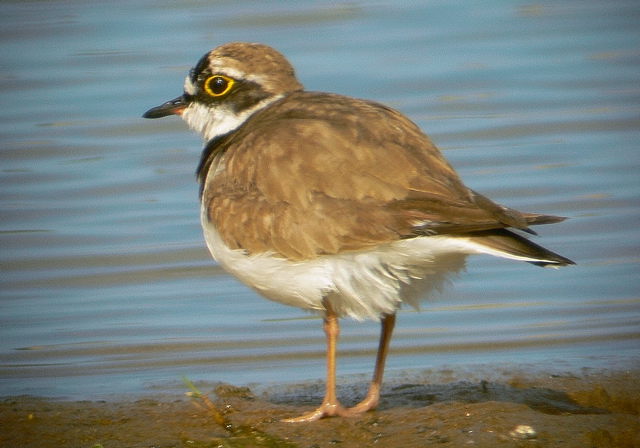

Dewi
What is the good of having a nice house without a decent planet to put it on? (H D Thoreau)
What is the good of having a nice house without a decent planet to put it on? (H D Thoreau)


